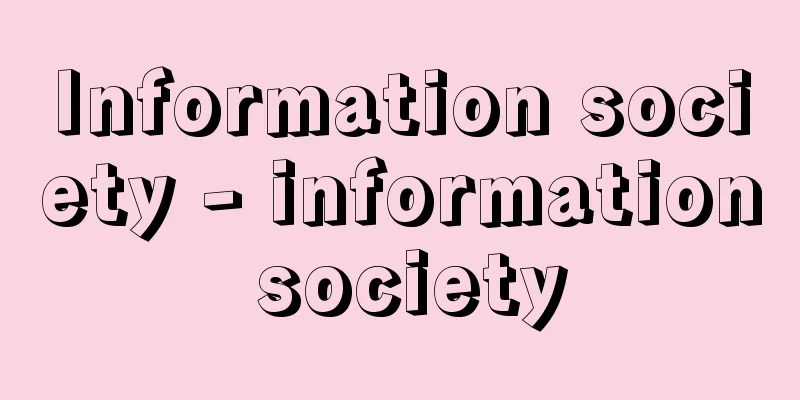Information society - information society

|
It is also called the information society. It is a society in which knowledge and information are dominant over material goods, i.e., things, assets, capital, and other financial power. From the late 1970s to the 1980s, developed countries such as the United States, Japan, the former West Germany, and the United Kingdom successively transitioned to an information society. [Toshiaki Yasuda] The theory of social developmentBehind the idea that advanced industrial countries are moving from an industrial society to an information society is the theory of gradual development of society. In other words, human beings first acquired agricultural technology as a means of production, forming an agricultural society where people cultivated fields. Then, with the Industrial Revolution, they achieved development into an industrialized society where they had abundant material goods through factory production. Then, with the development of telecommunications technology such as computers, telephones, and television broadcasting, they moved into a new society dominated by information, that is, an information society driven by the information revolution and information technology. As you can see, social development is divided into three very simple stages. This gave rise to the "third wave" theory of American futurist Toffler. The first wave was agriculture, the second was industry, and the third wave was information. Toffler's theory appeared in the 1980s, but this idea was also proposed by many social economists such as W. Rostow and D. Bell in the early 1960s. At that time, the new third society was defined as a post-industrial society. Around that time in Japan, Tadao Umesao published "Information Industry Theory" in the January 1963 issue of Broadcast Asahi, in which he developed his theory of three-stage development, which was reprinted in the March 1963 issue of Chuokoron and caused a great stir. Next, Kenichi Koyama (1933-1997) published "Introduction to Information Society Theory" in the Winter 1968 issue of Bessatsu Chuokoron Business Issues Special Issue, and in Japan, the definition of a new industrial form called the information industry was established, and the idea that a post-industrial society is an information society became established. It was not until the late 1970s in the United States that the post-industrial society was redefined as the information society. [Toshiaki Yasuda] Knowledge-intensive industrial structureIn response to the theories published by these Japanese researchers, the Japanese government began encouraging the Industrial Structure Council in the late 1960s to seek ways to reorganize the country's industrial structure to better suit the new era. The results of this effort bore fruit as the basic principles of trade and industry policy in the 1970s, heralding a major turning point for Japan's industrial policy. Specifically, instead of the previous policy of prioritizing the development of heavy chemical industries such as steel and petrochemicals, the government set out a shift to a knowledge-intensive industrial structure. What does it mean to be knowledge-intensive? To make steel or refine crude oil, large amounts of raw materials and heat sources are required. In that sense, heavy chemical industries can be considered resource- and energy-intensive industries. However, that steel is used to assemble automobiles. Moreover, it is not enough for these automobiles to simply run; they need to be fuel-efficient, have good performance, and have few breakdowns. Producing these requires excellent technological capabilities and a wealth of knowledge that makes this possible. In this way, even for the same industrial products, the focus is on producing highly technological products that are backed by knowledge. This is called a knowledge-intensive industrial structure. The information industry contributes to the accumulation and distribution of such knowledge. In the United States, F. Machalp of Princeton University proposed a new definition of the "knowledge industry" in the early 1960s. It is an industry involved in the production, reproduction, and distribution of knowledge. Specifically, this includes information-related industries such as education, broadcasting, publishing, and communications, computers, and electronics. Furthermore, the information industry, which combines communications and computers to create data banks and value-added networks (VANs) that accumulate, analyze, and quickly distribute large amounts of information, grew rapidly as a new business genre from the late 1970s through the 1980s. In the era of heavy and chemical industries, industries such as electricity and steel were the backbone that supported the foundations of society. With the development of a knowledge-intensive industrial structure, the information industry became the backbone industry. The new society that was formed in this way is called an information society. Among the developed industrial countries, Japan was one of the countries that completed the transition to an information society relatively early, with the goal of shifting to a knowledge-intensive industrial structure. The results were, for example, the success in producing internationally competitive products in the fields of automobiles, color televisions, and home VTRs from the late 1970s, and domination of the world market by the early 1980s. In the fields of LSI (large-scale integrated circuits) and VLSI, Japan's technological capabilities were also on a par with those of the world's leading United States, which led to a high evaluation of Japan's technological capabilities and became the driving force behind Japan's economic development in the 1980s. However, the Internet, which had previously been limited to academic research use, was opened to the private sector in the early 1990s, and America was the first to successfully popularize it on a mass scale, introducing information functions to its market economy under the new concept of IT (information technology), bringing about unparalleled economic prosperity in the 1990s. Meanwhile, while Japan is on par with America in the production capacity of Internet-related information and communication devices, it is lagging behind in overall information technology capabilities, such as the development and use of communication networks, and the development and improvement of these networks is a future challenge. However, since the late 1990s, Japan has been leading the world in both the rate of penetration and the extent of utilization in the field of mobile computing, which combines mobile phones and the Internet. [Toshiaki Yasuda] Life in the Information SocietyHow will people's lives change in the information society? Toffler's The Third Wave (1980) expresses this well. In this book, he proposes new concepts of the electronic office and the electronic cottage. The electronic office is a workplace that has been automated by office automation (OA), where corporate information is systemized using various computers and information devices. The electronic home refers to the home being electronic as well. If these two places are connected by high-performance communication lines, people will no longer need office work and will be able to do their work from home. Toffler defines this as telecommuting. This way of thinking has finally become feasible with the widespread use of the Internet, and it is no longer uncommon to see people working from home using Internet terminals at home or satellite offices near their homes, known as SOHOs (short for Small Office Home Offices). In addition, the use of the Internet for various purposes, such as teleshopping (online shopping), which allows users to obtain product data using home information devices such as personal computers and digital television broadcasting and place orders from their own information terminals, and medical consultation and other information consulting services, has become a reality. These were described as dreams in Toffler's "The Third Wave," but with the spread of the Internet, they have become commonplace, and a wide range of applications, from practical ones such as Internet banking and electronic payment, to leisure and hobbies, have become commonly accepted. Furthermore, the development of networks has established systems for the use of information across regions, workplaces, and companies. Of particular note is the active use of the Internet in medical activities, as seen in the network for information on treatment measures for mass food poisoning and other cases, and the system for the rapid exchange of specialized knowledge between doctors, such as the organ transplant information network. To realize these technological goals, since the 1980s, companies have been developing information devices and technologies to promote office automation, and LANs (local area network) have been established. Meanwhile, in the home, the spread of everyday information devices such as personal computers and the development of technologies to utilize them have been promoted, and plans to upgrade communication networks such as INS (Advanced Information and Telecommunications Systems) to facilitate smooth information exchange have been promoted. Since the 1990s, the development of information and communication networks has come to be seen as based on the Internet, and progress has been made with the practical application of ISDN (Integrated Services Digital Network) and ADSL (Asymmetric Digital Subscriber Line), which enable high-speed, large-capacity communication over regular telephone lines, as well as the spread of optical fiber to ordinary homes and the use of digital satellite broadcasting and CATV (cable television). [Toshiaki Yasuda] The Light and Shadow of the Information SocietyAs industrial production capacity increases and technology becomes more advanced, there is a tendency for management and control to become more extensive. In other words, one of the aims of information technology is to improve the efficiency of management and control mechanisms. The idea of the information society is to apply the information technology that has arisen from this to everyday life, including the home, to enrich people's lives not only materially but also spiritually. In this sense, the information society is truly a utopian ideal, but we must also be aware that there are pitfalls behind it. Invasion of privacy was pointed out early on as a dangerous aspect of the information society. In particular, there is concern about indiscriminate invasion of privacy by the commercial information industry, rather than by authorities. For example, let's say you shop on the Internet. The data is stored in a computer each time you shop, and is compared with past records and payment records. Eventually, it becomes possible to infer the family structure and financial capabilities of the household. The power of the information society is that it makes this possible, but it can be frightening if such data is used without discretion. Already, many people are bombarded with mountains of direct mail, and plagued by endless sales calls and e-mails, but this is also one of the negative effects of the information society. With the advancement of information technology, anyone can operate a high-performance computer. As a result, computer crime has become a problem. A classic example of this is the crime of sneaking into a computer room and falsifying or destroying data and information. Furthermore, as technology has become more advanced, there has been concern about intrusion into computer systems from unknown parties, whose location and identity cannot be identified, via communication lines. In particular, there are many cases where, without any criminal intent, a person connects to someone else's system out of mere technical interest and causes serious damage as a prank. These criminals are defined as hackers, and the damage they cause is characterized by the fact that it does not care about national borders. Therefore, in the late 1990s, under the discussions of the G8 (G8 Conference of Eight Competent Governments), which consists of the seven advanced countries and Russia, each country began to take measures against information crimes such as cyber terrorism (large-scale destructive activities against information infrastructure such as the Internet). In Japan, in 2000, hackers illegally accessed the systems of about 20 central government ministries and agencies, and internal information was rewritten or erased. With the spread of online transactions, there has been a constant stream of crimes, such as the misuse of other people's IDs (authentication numbers) and passwords, and breaking into systems to destroy data. In response, the Law Prohibiting Unauthorized Access to Computer Systems came into effect in February 2000, and efforts are being made to establish information security against such high-tech crimes. Not only crime, but a defining feature of the information society is the ease with which an abundance of information can be accessed. For this reason, value judgments and the ability to choose what to accept and what to reject (information literacy) become important issues. The more information society advances, the more individuals are required to establish their own autonomy. Some also define those who are information literate as the information rich and those who are not as the information poor, calling the disparity between the two the digital divide, and sounding the alarm about the emergence of new discrimination. [Toshiaki Yasuda] "Japan's Information Industry, edited by YTV Information Industry Research Group, 3 volumes (1975, Simul Publishing)" ▽ "The Third Wave, by A. Toffler, translated by Tokuyama Jiro and Suzuki Kenji (1980, NHK Publishing)" ▽ "University of Tokyo Open Lecture Series 39: Informationization and Society, by Hirano Ryuichi et al. (1984, University of Tokyo Press)" ▽ "How will the advanced information society change humans? (1984, TBS Britannica)" ▽ "The Age of Netizens, by Kumon Shumpei (1996, NTT Publishing)" ▽ "Culture of the Information Society, edited by Aoki Tamotsu, Kajiwara Kageaki, et al., 4 volumes (1998-1999, University of Tokyo Press)" ▽ "The Arrival of the Digital Millennium: Consumers in the Internet Society, by Nawa Kotaro (1999, Maruzen)" ▽ "Information Society and Human Rights, New Edition, by Yamashita Eiichi and Inoue Yoichi (2000, Akashi Shoten)" ▽ "What is the Digital Divide, by Kimura Tadamasa (2001, Iwanami Shoten)" ▽ "The Japanese Information Society: Challenges from Local Communities, by Miyao Takahiro (Chikuma Shinsho)" [References] | | | | | | | | | | | | | | |©Shogakukan "> The rise of the information society Source: Shogakukan Encyclopedia Nipponica About Encyclopedia Nipponica Information | Legend |
|
情報社会ともいう。物財、すなわち、物や、資産、資本などの財力にかわって、知識や情報が優位となる社会で、1970年代後半から1980年代にかけて、アメリカ、日本、旧西ドイツ、イギリスなどの先進工業諸国は相次いで情報化社会に移行した。 [安田寿明] 社会の段階的発展説先進工業諸国が工業化社会から情報化社会に移行するという考え方の背後にあるのは、社会の段階的発展説である。つまり人類は、最初の生産手段として農耕技術を手にし、田畑を耕す農業化社会を形成した。ついで産業革命によって、工場生産による豊富な物財を手にする工業化社会への発展を成し遂げた。そしてコンピュータや、電話、テレビ放送などの電気通信技術の発展で、情報を主体とする新しい社会、すなわち情報革命と情報技術による情報化社会に移行していったとするものである。これでもわかるとおり、社会の発展がごく単純に3段階に分類されている。そこから出てきたのがアメリカの未来学者トフラーの「第三の波」説である。第一の波が農業、第二が工業、そして第三の波が情報というわけである。 トフラーの説は1980年代に登場したが、この考え方は1960年代初めに、W・ロストウ、D・ベルなど多くの社会経済学者から提言されていたものでもある。当時は新しい第三の社会のことをポスト・インダストリアル・ソサエティー(脱工業化社会)と定義していた。そのころ日本では、梅棹忠夫(うめさおただお)が『放送朝日』1963年(昭和38)1月号に「情報産業論」を発表し、三段階発展説の所説を展開、『中央公論』1963年3月号に転載されて大反響をよんだ。ついで香山(こうやま)健一(1933―1997)が「情報社会論序説」を『別冊中央公論経営問題特集』1968年冬季号に発表、日本では情報産業という新産業形態の定義が確立し、脱工業化社会とは情報化社会であるとの観念が定着した。脱工業化社会が情報化社会として再定義されたのは、アメリカにあっては1970年代後半になってからであった。 [安田寿明] 知識集約型産業構造これらの日本人研究者の学説発表に呼応して、日本政府は1960年代後半から産業構造審議会を督励し、新しい時代に対応した産業構造再編成への道を模索し始めた。その成果が1970年代の通商産業政策の基本方針として実を結び、日本の産業政策は重大な転換期を迎えることとなった。具体的には、それまでの鉄鋼や石油化学などの重化学工業育成重視の政策ではなく、知識集約型産業構造への転換を打ち出したのである。 知識集約型とはどういうことであろうか。鉄をつくるとか、原油を精製するには、大量の原材料と熱源が必要である。重化学工業は、その意味で、いわば資源・エネルギー集約型産業と考えられる。しかし、その鉄をもとに自動車を組み立てる。しかも、その自動車は単に走ればよいというのではなく、低燃費で性能がよく、故障が少ないものが必要とされる。これを生産するには、優れた技術力と、それを可能にする豊富な知識がなければならない。このように同じ工業製品でも、知識力を背景にした高度技術製品の生産に主力を注ぐ。これを知識集約型産業構造というのである。 そのような知識の蓄積や流通に寄与するものは情報産業である。アメリカでは1960年代の初め、プリンストン大学のF・マハルプが「知識産業」という新しい定義を提案している。知識の生産・再生産・流通にかかわる産業のことである。具体的には、教育、放送、出版業をはじめ、通信、コンピュータ、エレクトロニクスなどの情報関連諸産業が当てはまる。そして、通信とコンピュータを結合し、大量の情報を蓄積、分析して迅速に分配するデータバンクや付加価値通信網(VAN(バン))などの情報産業が、新しいビジネス・ジャンルとして1970年代後半から1980年代全般にかけて急速に成長していった。 重化学工業の時代では、電力とか鉄鋼などの産業が、いわば社会の基盤を支える基幹的存在である。それが知識集約型産業構造の進展に伴って、情報産業が基幹的産業となってくる。このようにして形成される新しい社会を情報化社会というのである。先進工業国のなかでは、日本は知識集約型産業構造への転換を目標に掲げて、比較的に早くこの情報化社会への移行を終えた国の一つである。その成果が、たとえば自動車やカラーテレビジョン、あるいはホームVTRの分野で国際競争力の強い製品の生産に1970年代後半から成功し、1980年代初めには世界市場を制覇するに至った。またLSI(大規模集積回路)や超LSIの分野でも、世界のトップをいくアメリカの実力にほぼ伯仲するまでになり、日本の技術力に対する評価が高まり、1980年代の日本経済発展の原動力となった。しかしながら、学術研究利用に限られていたインターネットが1990年代初めに民間にも開放され、その大衆的普及にいち早く成功したアメリカは、IT(情報技術)という新概念のもと市場経済に情報化機能を導入、1990年代の比類のない経済的繁栄をもたらした。一方、日本はインターネット関連の情報通信機器の生産力ではアメリカと肩を並べるものの、通信網の整備と利用など総合的な情報技術力では遅れをとっており、その整備と充実が今後の課題となっている。ただし1990年代末以降、携帯電話とインターネットを結合したモバイルコンピューティングの分野では、普及率、活用の度合いともに日本は世界のトップを進みつつある。 [安田寿明] 情報化社会の生活情報化社会で人々の生活がどう変化するか。それを巧みに表現したのがトフラーの『第三の波』(1980)である。彼はこの著書のなかでエレクトロニック・オフィス(電子化事務所)とエレクトロニック・コテージ(電子化家庭)という新しい概念を提案している。電子化事務所というのは、オフィスオートメーション(OA)化された職場のことで、企業情報が各種のコンピュータや情報機器によってシステム化されている。また電子化家庭は、同じく家庭もまた電子情報化されていることをさす。その間を高性能な通信線で結べば、人々はもはやオフィス・ワークを必要とせず、家庭にいながらにして会社の用を足せるというのである。トフラーはこれを在宅勤務telecommutingと定義している。このような考え方はインターネットの大衆的普及によって、ようやく実現可能となり、SOHO(ソーホー)(Small Office Home Officeの略)とよばれる、家庭内のインターネット端末や自宅近くのサテライト事務所で業務をこなす例も珍しいことではなくなった。 また、パソコンやデジタル・テレビ放送など家庭の情報機器を利用して商品データを取り寄せ、手元の情報端末から買い物の発注ができるテレショッピングteleshopping(オンライン・ショッピング)や、医療相談などの案内コンサルティング・サービスをはじめとする各種の生活情報化への活用も現実のものとなった。これらはトフラーの『第三の波』で夢物語として語られていたものだが、インターネットの普及であたりまえのものとなり、インターネットバンキング、代金支払いの電子決済など実用的なものから、遊びや趣味に至る幅広い応用が一般的なものとして受け入れられるようになった。また、ネットワークの発達によって、地域、職域、企業間を問わぬ情報活用体制が確立されている。とりわけ注目されるのは、集団食中毒などでの治療対策情報網、臓器移植情報網など医師間の専門知識の迅速な交換体制などにみられる、医療活動へのインターネットの積極的な活用である。 これらを技術的に実現するため、1980年代以降、企業にあってはOA化推進のための情報機器や技術の開発、LAN(構内情報通信網)の整備が進められた。一方、家庭にあってはパソコンなど生活情報機器の普及とその活用技術の開発、また、情報交流を円滑化するためのINS(高度情報通信システム)などの通信網高度化計画が推進されていった。1990年代以降、情報通信網の整備はインターネットを基幹として考えられるようになり、通常の電話線で高速大容量通信が可能なISDN(統合サービスデジタル網)やADSL(非対称デジタル加入者回線)などの実用化をはじめ、一般家庭への光ファイバーの普及やデジタル衛星放送、CATV(有線テレビ)などの活用が進められている。 [安田寿明] 情報化社会の光と影工業生産力が増大し、技術が高度化すると、それに伴って管理と制御の面が肥大化する傾向がある。すなわち管理や制御機構の効率化を図るというのが情報化のねらいの一つでもある。そこから生まれた情報技術を、家庭をはじめとする生活の場にも応用し、人々の暮らしを物質的だけでなく精神的にも豊かなものにしようというのが情報化社会の理念でもある。こう考えると、情報化社会はまさにユートピアの理想でもあるが、その背後には、やはり落し穴があることにも留意しておかなければならない。 情報化社会の危険な側面として早くから指摘されていたのはプライバシーの侵害である。それも、権力機関によるものよりも、商業主義的な情報産業の無差別なプライバシー侵害が心配されている。たとえばインターネットで買い物をしたとしよう。そのデータはそのつどコンピュータに蓄積され、過去の資料や、代金決済記録と照合される。やがて、その家庭の家族構成や資産能力などが類推できるようになる。こうしたことが可能になるのが情報化の威力でもあるが、そうした資料が分別なしに活用されるようになると恐ろしいことになる。すでにダイレクト・メールの山にさらされる人や、のべつ幕なしのセールス電話や電子メールに悩まされる人も多くなってきているが、これも情報化の弊害の一つである。 また情報化の進展に伴い、高性能なコンピュータがだれでも操作できるようになった。その結果として問題が出てきたのがコンピュータ犯罪である。これの古典的なものとしては、コンピュータ室に忍び込み、データや情報を改竄(かいざん)したり破壊するなどの犯罪がある。さらに、技術が高度化するにつれ、通信線を介して、場所や人間を特定できない何者かからのコンピュータシステムへの侵入が心配されるようになった。とりわけ、犯意はなくとも単なる技術的興味から他人のシステムに接続し、いたずら半分に重大な障害を与えるケースも多い。こうした犯罪者をハッカーhackerという用語で定義しているが、彼らによる被害は国境を問わないことに特徴がある。そこで、1990年代後半からは先進7か国にロシアを加えたG8(8か国主務官庁会議)での協議のもと、各国はそれぞれサイバーテロ(インターネットなどの情報インフラに対する大規模な破壊活動)などの情報犯罪対策に取り組むようになった。日本でも、2000年(平成12)に約20の中央省庁のシステムがハッカーに不正アクセスされ、内部の情報が書きかえられたり、消されたりという事件がおこった。ネットワーク上の取引の普及に伴い、他人のID(認証番号)やパスワードの悪用、システムに侵入してデータを破壊するなどの犯罪が後を絶たず、2000年2月には不正アクセス禁止法が施行されるなど、こうしたハイテク犯罪に対する情報セキュリティ確立のための法律整備が図られている。 犯罪ばかりでなく、情報化社会の特徴は、あふれんばかりの情報がしごく手軽に入手できることである。それだけに、それらの価値判断や取捨選択(情報リテラシー)は重要な問題となってくる。情報化が進展すればするほど、個人としての主体性の確立が要求されるのである。また、情報リテラシーを保有する人を情報富者、そうでない人を情報貧者と定義し、両者の格差をデジタル・デバイドdigital divideと称して新たな差別の発生に警鐘を鳴らす向きもある。 [安田寿明] 『YTV情報産業研究グループ編『日本の情報産業』全3巻(1975・サイマル出版会)』▽『A・トフラー著、徳山二郎・鈴木健次訳『第三の波』(1980・日本放送出版協会)』▽『平野龍一他著『東京大学公開講座39 情報化と社会』(1984・東京大学出版会)』▽『増田米二・正村公宏著『高度情報社会は人間をどう変えるか?』(1984・TBSブリタニカ)』▽『公文俊平著『ネティズンの時代』(1996・NTT出版)』▽『青木保・梶原景昭他編『情報社会の文化』全4巻(1998~1999・東京大学出版会)』▽『名和小太郎著『デジタル・ミレニアムの到来――ネット社会における消費者』(1999・丸善)』▽『山下栄一・井上洋一著『情報化社会と人権』新版(2000・明石書店)』▽『木村忠正著『デジタルデバイドとは何か』(2001・岩波書店)』▽『宮尾尊弘著『日本型情報化社会――地域コミュニティからの挑戦』(ちくま新書)』 [参照項目] | | | | | | | | | | | | | | |©Shogakukan"> 情報化社会の成立 出典 小学館 日本大百科全書(ニッポニカ)日本大百科全書(ニッポニカ)について 情報 | 凡例 |
<<: Intelligence agency - information agency
>>: Information science - information science
Recommend
Parody - Gibun
...It translates to humorous writing, parody poet...
Graffiti
A text input method used in PalmOS. When you write...
Viṭhobā (English spelling)
…His family belonged to the Kumbī (farming) caste...
Huang Yuan Yong (English: Huáng Yuǎn yōng)
1884‐1915 Chinese journalist. Born in Hangzhou, Zh...
North Pacific Experiment
...The group was comprised mainly of American mar...
Mukabaki
A travel item worn around the feet. The style vari...
Moriyoshi Iseki
...In London, they became popular in Piccadilly a...
Johanson, CE
…Both ends of a rectangular cross section are fin...
The Godfather
American film. 1972. Directed by Francis Ford Cop...
Burbot (English spelling) Lota lota;
A freshwater fish of the family Gadidae. It can re...
Minamiaiki [village] - Minamiaiki
A village in Minamisaku District, eastern Nagano P...
Kitayama River
This river originates near Obamine Pass in Yoshin...
Urotropin
Hexamethylenetetramine is a white, soluble powder ...
Tan Zoumaïtak (English spelling)
…The area is now a completely dry, rugged mountai...
Ypsiscarus ovifrons (English spelling) Ypsiscarus ovifrons
...It is delicious in winter and can be eaten raw...









